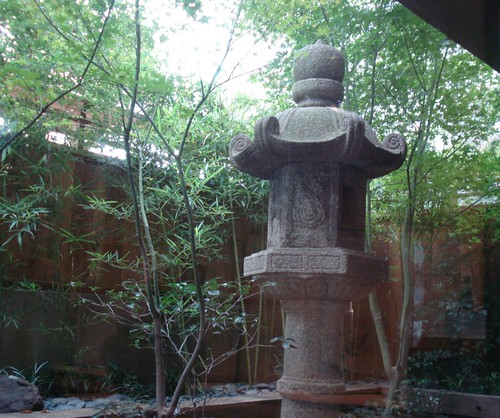Students will create a colorful, carefully sketched, one-page representation of the characteristics of a Japanese garden in class.
Background -
Some of the Japanese gardens most famous in the West, and within Japan as well, are dry gardens or rock gardens, karesansui, says Wikipedia.
The tradition of the Tea masters has produced highly refined Japanese gardens of quite another style, evoking rural simplicity. In Japanese culture, garden-making is a high art, intimately related to the linked arts of calligraphy and ink painting.
The tradition of Japanese gardening was historically passed down from sensei to apprentice.
Typically a visitor will find -
- Water, real or symbolic.
- A bridge or stepping stones.
- Rocks or stone arrangements (or settings).
- A lantern, typically of stone.
- A teahouse or pavilion.
- A hedge, fence, or wall.
Karesansui gardens (枯山水) or "dry landscape” gardens were influenced mainly by Zen Buddhism and can be found at Zen temples of meditation. The raked gravel or sand simulates the feeling of water. The rocks or gravel used are chosen for their artistic shapes, and mosses as well as small shrubs are used to represent ponds, islands, boats, seas, rivers, and mountains in an abstract way.
skip to main |
skip to sidebar
For students and parents who love education and exploration of the social sciences . . .
Search This Blog
Followers
Blog Archive
-
▼
2011
(242)
-
▼
May
(27)
- Ni hau! Sayonara! Salaam! Shalom! Namaste! Ciao! A...
- Tokyo to Totoro quiz
- Caddo peoples established trade road that connecte...
- Semester exam: 100 questions from the online quizz...
- Known colloquially as Oz, the name Australia means...
- A small quiz on the 50th state, Hawaii
- The in-class Japanese garden project
- Pearl Harbor: Honolulu, Oahu, Hawaii
- Adding Australia to the map of East Asia
- Transformations: the British-Japanese movie Howl's...
- Japan WWII: a military-dominated society
- Magnet geography: Japan
- Nippon review questions
- Howl's Moving Castle and Cosplay
- Bento: Japanese lunch in a beautiful box
- The Godfather of Anime, the late Japanese artist O...
- Miyazaki Hayao Miyazaki and the Japanese sense of ...
- Pictorial report on Japan
- Semester exam: 100 multiple choice questions pulle...
- Basic Japanese phrases
- From the Red Sea to the mountains of the Hindu Kus...
- Saddam Hussein and Osama bin Laden; which is which?
- Osama bin Laden's beliefs
- Buddhism and spiritual rebirth
- Karma in the Buddhist way
- Buddhism and Siddhartha Gautama
- The 4 Noble Truths: basics of the path called Budd...
-
▼
May
(27)

